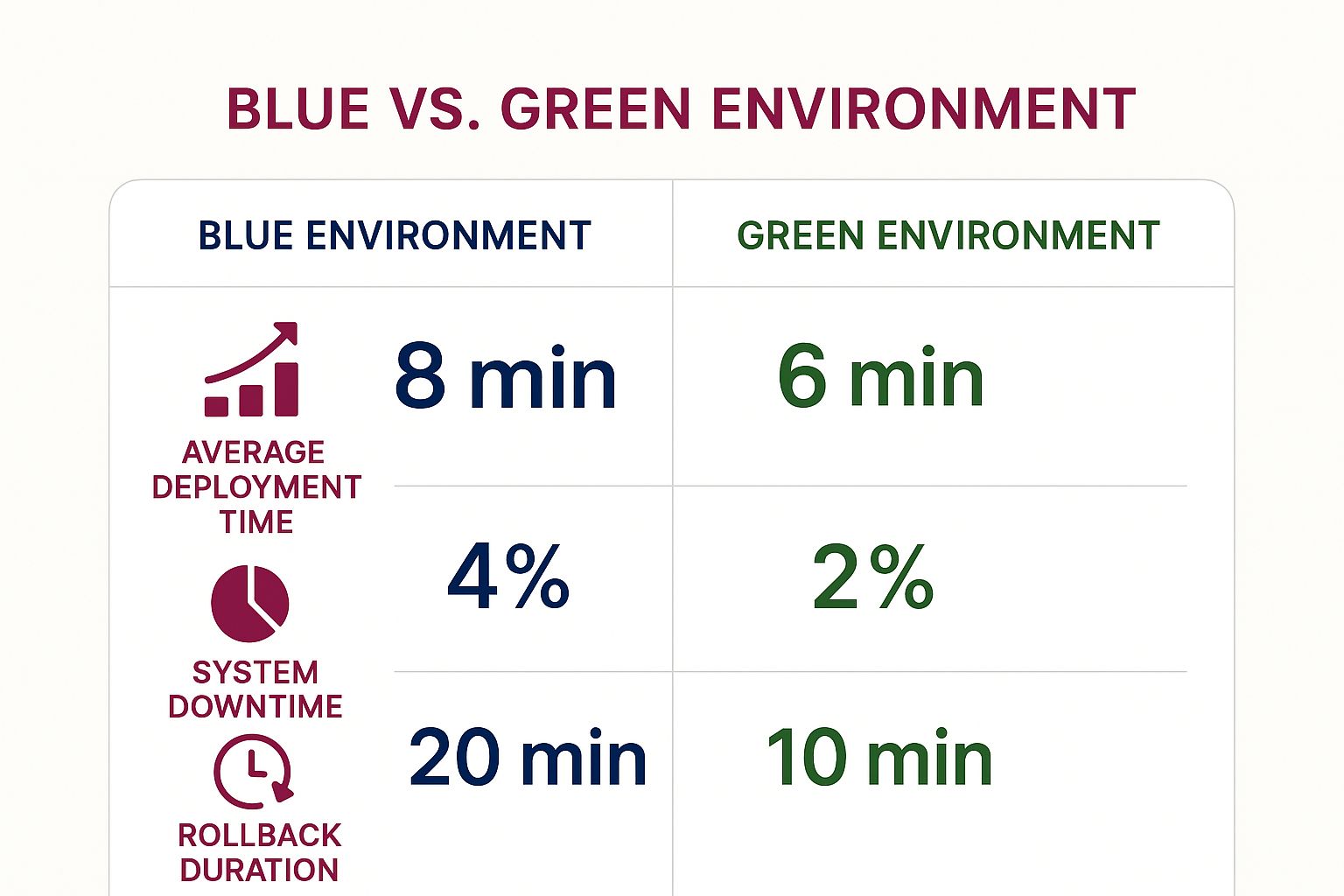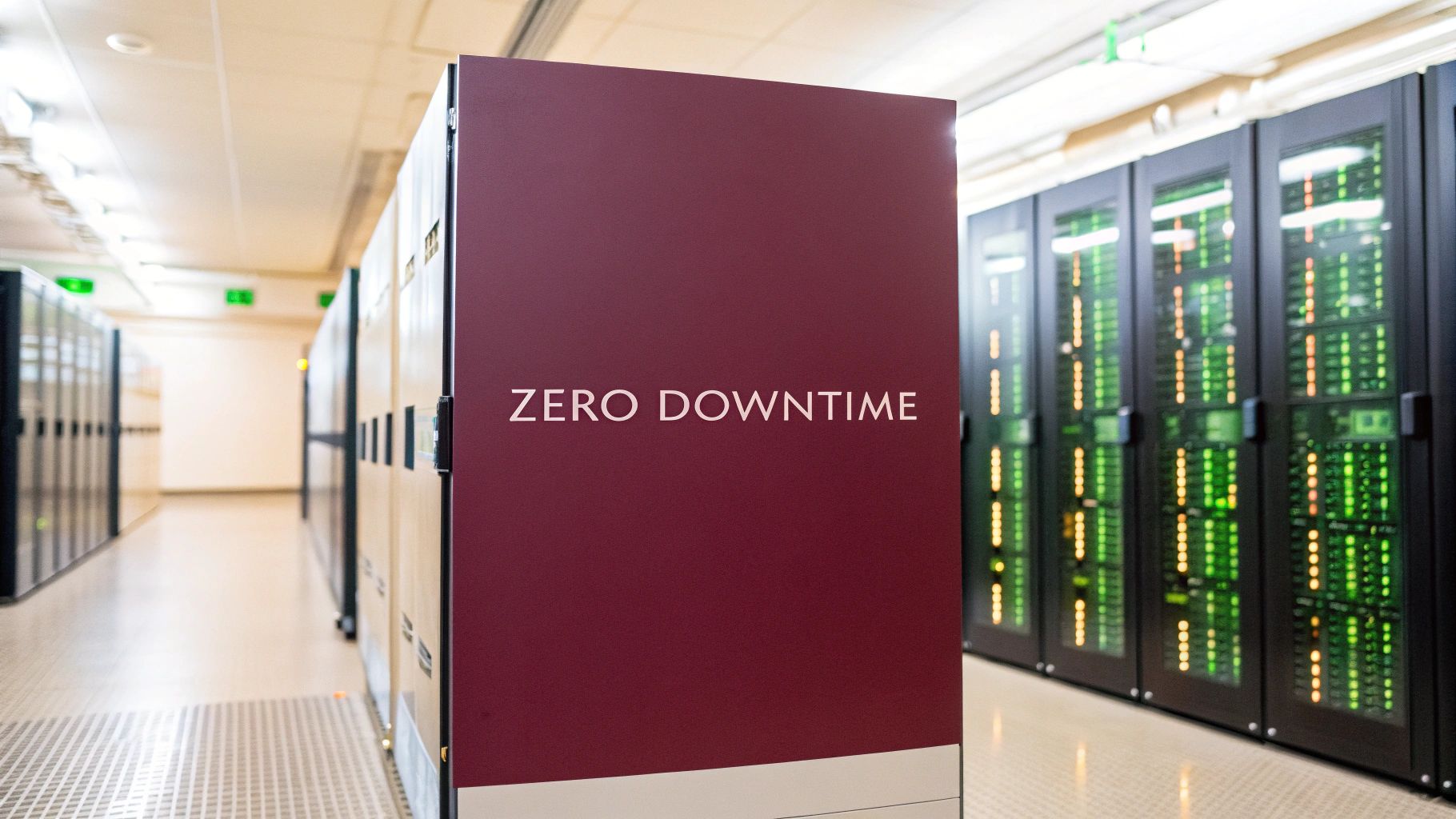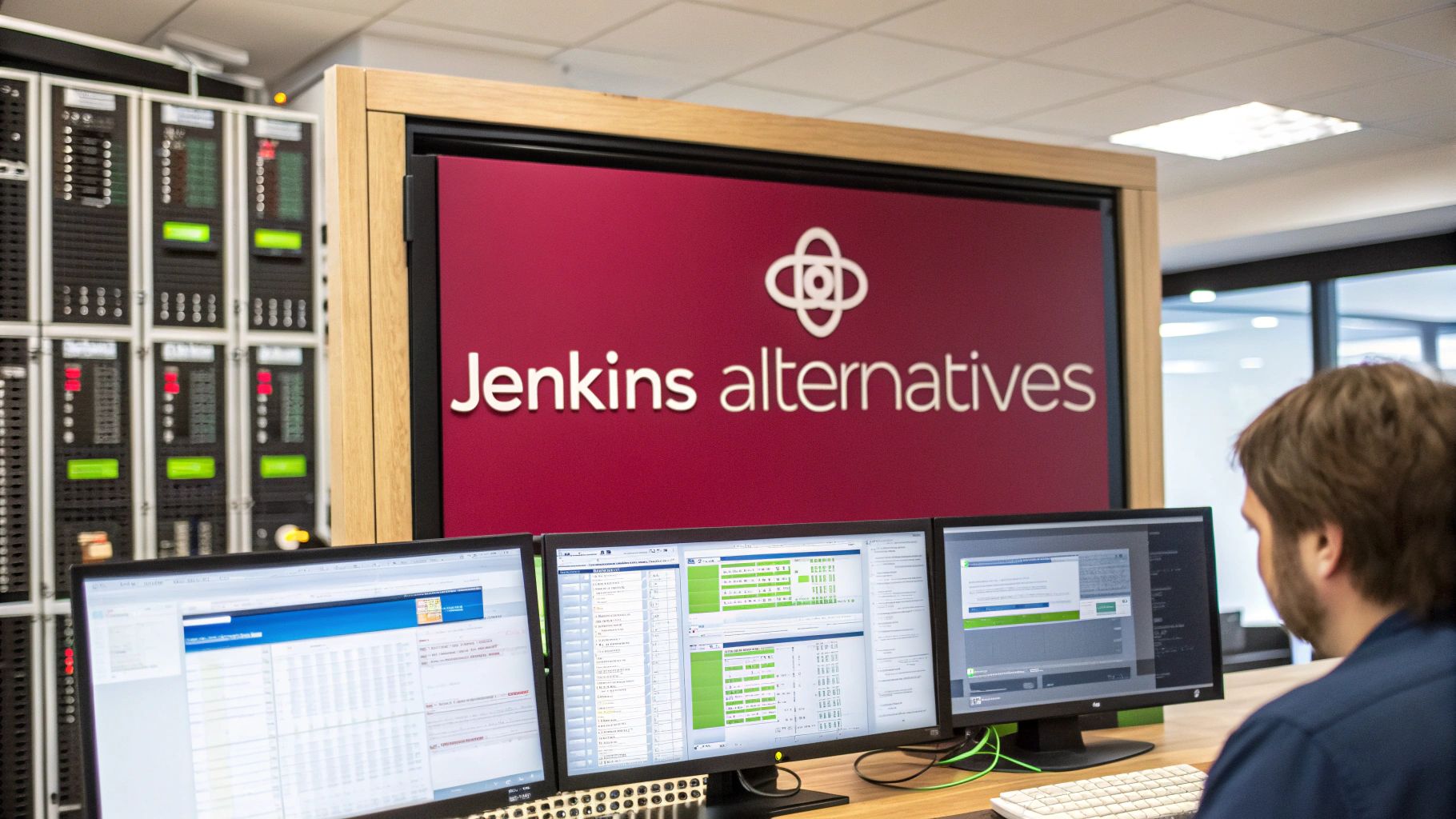The Blueprint of Blue Green Deployment Strategy

The blue green deployment strategy is a modern approach to software releases that minimizes downtime and risk. Imagine two identical production environments: “blue” and “green.” One environment (e.g., blue) serves live traffic, while the other (green) is a staging area for the next release. This setup allows for thorough testing and preparation.
This differs significantly from traditional deployments, which often caused service interruptions. Blue green deployments allow new code to be deployed and tested in a production-like environment before going live. This reduces the likelihood of unexpected issues after release. For real-world examples, see Tevello Success Stories.
Blue-green deployment, recognized in the early 2000s, improved software release strategies. Maintaining two identical environments (“blue” and “green”) is key. One (e.g., blue) serves live traffic, while the other (green) stages the next release. New versions are deployed to green, tested, and then traffic is switched from blue to green. Learn more about blue-green deployment.
How the Switch Happens
The transition is typically managed through DNS updates or load balancers. These redirect traffic seamlessly from the old environment to the new, ensuring a smooth user experience with minimal interruption.
Learn more about various deployment strategies at How to master deployment strategies. A major benefit is easy rollback. If problems arise after switching to green, traffic can be immediately redirected back to blue, minimizing user impact.
Key Advantages of Blue Green Deployments
- Reduced Downtime: Minimizes user interruptions during deployments.
- Easy Rollback: Enables quick reversion to the previous version.
- Improved Testing: Allows thorough testing in a production-like environment.
- Reduced Risk: Decreases the chance of unexpected problems.
This easy switching makes blue green deployment powerful for continuous availability and an improved user experience.
Why Blue Green Deployment Strategy Outperforms Alternatives
The blue green deployment strategy offers a significant advantage over traditional methods: reduced risk and near-zero downtime. Updating applications with traditional approaches often means interrupting service while implementing changes. Blue green deployments, however, deploy updates to an inactive environment, allowing for thorough testing before seamlessly switching over. This results in a smoother transition and a better user experience.
The following infographic visualizes key metrics comparing blue and green environments in a blue/green deployment: average deployment time, system downtime, and rollback duration.

As the infographic shows, blue green deployments minimize downtime and enable significantly faster rollbacks than traditional methods. This drastically reduces the impact of potential issues on end-users. It also fosters a culture of confidence in releases, empowering development teams to deploy more frequently. For more information on continuous integration, check out this resource: How to master continuous integration.
Reduced Risk and Faster Rollbacks
A primary benefit of blue green deployments is the ability to instantly roll back if problems arise after the switch. Simply redirect traffic back to the previous environment—a process often as easy as flipping a switch. This minimizes user impact and allows developers to address issues promptly.
Statistical analyses demonstrate this approach’s effectiveness. Blue-green deployments significantly mitigate deployment risks. Companies using this strategy have reported reducing deployment-related incidents by over 70%, with some achieving near-zero critical deployment failures. Amazon Web Services (AWS) documentation shows customers using their blue-green deployment frameworks experienced a dramatic reduction in application downtime, going from minutes or hours to near zero. Explore this topic further with AWS: Blue/Green Deployments on AWS.
Enhanced Testing and Controlled Rollouts
Blue green deployments facilitate comprehensive testing in a production-identical environment, mitigating the “it worked on my machine” scenario. This approach also enables powerful A/B testing capabilities. Deploying different features to each environment and directing traffic to each allows for direct comparisons of user engagement and performance.
This leads to more informed decisions regarding feature releases and enhancements. It also supports controlled feature rollouts, allowing new features to be gradually released to a subset of users on the green environment before full rollout. This limits the impact of unforeseen issues.
To further illustrate the differences, the following table compares blue green and traditional deployment strategies across key operational factors.
Blue Green Deployment vs. Traditional Deployment
A comparison highlighting the key differences between blue green deployment strategy and traditional deployment approaches across various operational factors
| Factor | Blue Green Deployment | Traditional Deployment |
|---|---|---|
| Downtime | Near-zero | Significant, often minutes or hours |
| Rollback Capability | Instantaneous, simple switch | Complex, time-consuming, often requires redeployment |
| Risk Mitigation | High, due to pre-production testing and easy rollback | Lower, higher chance of impacting users |
| Testing Environment | Production-identical | May not perfectly mirror production |
| Deployment Complexity | Higher initial setup, simpler execution | Simpler initial setup, potentially more complex execution |
| Cost | Higher infrastructure cost due to maintaining two environments | Lower infrastructure cost |
This table highlights the key advantages of blue green deployment—minimized downtime, instant rollback capabilities, and enhanced risk mitigation—compared to traditional deployment. While blue green may have higher initial setup complexity and infrastructure costs, the benefits often outweigh these considerations, particularly for applications where downtime and risk are major concerns.
Overcoming Blue Green Deployment Strategy Challenges
Implementing a blue green deployment strategy, while offering significant advantages, also presents unique challenges. One major hurdle is the increased infrastructure investment. Maintaining two identical production environments naturally increases costs. This requires careful cost-benefit analysis, especially for smaller organizations. However, for applications where even short downtimes translate to substantial revenue loss, the investment is often justified.
Additionally, database synchronization can be a pain point. Maintaining data consistency between the blue and green environments during the switchover can be complex. For example, schema changes deployed to the green environment must be carefully synchronized with the blue environment. This prevents data corruption and application errors and often requires specialized tooling and planning. Check out this guide on How to master deployment optimization.
Managing Operational Complexity and the Skills Gap
Another challenge is the increased operational complexity. Managing two separate environments requires robust automation and orchestration. This can strain teams accustomed to traditional deployments. Blue green deployments demand operational discipline and sophisticated automation. Studies show over 80% of organizations successfully using this strategy invest heavily in continuous delivery (CD) and infrastructure automation tools. Automation enables reliable deployments to the green environment, automated health checks, and near-instantaneous traffic switching. Learn more about blue-green deployment strategy advantages.
Further compounding this is the skills gap. Implementing blue green deployments requires expertise in areas like containerization, infrastructure as code, and automated testing. Bridging this gap might involve upskilling existing teams or hiring specialists. However, with careful planning and training, teams can acquire the necessary skills without disrupting existing workflows.
Practical Solutions and Strategies
Fortunately, these challenges are not insurmountable. Several strategies and tools exist to help. Using infrastructure-as-code tools like Terraform ensures consistency between environments, minimizing configuration drift. This simplifies environment management and reduces errors during deployments.

Additionally, investing in comprehensive monitoring and alerting systems is crucial. These tools provide real-time visibility into the health and performance of both environments. This allows for rapid issue detection and resolution. They also help identify potential problems proactively. Incorporating automated rollback procedures is also a best practice. This allows quick reversion to the previous stable version if issues arise, minimizing user disruption. You might be interested in: How to master deployment optimization. By addressing these challenges proactively, organizations can successfully leverage blue green deployments and benefit from increased reliability, reduced downtime, and enhanced agility.
Essential Tools That Power Blue Green Deployment
Successfully implementing a blue green deployment strategy depends significantly on utilizing the correct tools. These tools automate processes, maintain consistency, and handle the inherent complexities of switching between environments. Let’s explore the key tools categorized by their function, offering selection criteria based on team size and application requirements.
Containerization: Docker and Kubernetes
Containerization technologies like Docker and Kubernetes are essential for blue green deployments. They encapsulate applications and their dependencies into isolated units, ensuring consistent performance across various environments. Docker provides the container image format, while Kubernetes orchestrates deployment, scaling, and management of these containers. This powerful combination creates a predictable and reliable foundation, especially for large-scale deployments.
For instance, consider deploying a new application version. Using Docker, you package the updated code and dependencies into a fresh container image. Kubernetes then deploys this image to the green environment, ensuring it mirrors the blue environment’s functionality. This eliminates inconsistencies and reduces unforeseen issues during the switchover.
CI/CD Automation: Jenkins and GitHub Actions
Continuous Integration/Continuous Delivery (CI/CD) tools automate the deployment pipeline, streamlining code changes’ building, testing, and deployment. Tools like Jenkins and GitHub Actions orchestrate the intricate steps involved in blue green deployment. They automate tasks such as building new container images, deploying to the inactive environment, executing tests, and managing the traffic switch. This automation minimizes manual intervention, reducing human error and boosting deployment speed. Check out our guide on How to master CI/CD pipelines.
Load Balancing: Managing Traffic Flow
Load balancers are critical for directing traffic between blue and green environments. They function as traffic controllers, routing user requests to the active environment. During a blue green deployment, the load balancer configuration updates to seamlessly transition traffic from blue to green without user interruption. This enables continuous service during deployments. Different load balancing solutions offer various features like health checks and advanced traffic routing algorithms for a smooth, efficient transition.
Infrastructure as Code: Terraform
Infrastructure as Code (IaC) tools like Terraform manage and provision infrastructure through code, ensuring environment consistency and eliminating configuration drift. This common issue arises when environments gradually diverge due to manual changes. Terraform lets you define your entire infrastructure (servers, networks, load balancers) in code. This code then automatically creates and configures both blue and green environments identically, guaranteeing parity and minimizing deployment errors.
Choosing the Right Toolset
Choosing the right tools depends on several factors: your team’s technical expertise, application complexity, and budget. Smaller teams with simpler applications might choose straightforward tools like GitHub Actions and basic load balancers. Larger organizations with complex deployments often require the robust capabilities of Kubernetes, Jenkins, and Terraform. Regardless of the chosen tools, integrating and automating them is key for a seamless and reliable deployment pipeline.
Implementing Your First Blue Green Deployment Strategy

Moving from theory to practice, let’s outline how to implement a blue green deployment strategy. The process begins with environment setup and ends with your first zero-downtime release. Your initial focus should be preparing your infrastructure and establishing configuration parity between the blue and green environments. This means ensuring identical hardware, software, and configurations in both. This foundation is key to minimizing discrepancies and ensuring predictable behavior during the switchover.
Next, build the deployment pipelines to automate the complex orchestration involved in blue green deployments. When planning, consider the different deployment strategies and architectures available. See the available deployment options for more information. Automating this process minimizes manual intervention and reduces the risk of human error.
The Deployment Workflow
The core deployment workflow consists of four key stages:
-
Prepare the Inactive Environment: Ensure the green environment is updated with the latest stable release, mirroring the current production (blue) environment. This prepares the ground for deploying the new code.
-
Deploy New Code: Deploy the new code to the inactive (green) environment. Use the same automated processes used for the blue environment to maintain consistency.
-
Perform Thorough Validation: Rigorously test the new code in the green environment. This includes running automated tests, performing user acceptance testing (UAT), and monitoring performance metrics. This validation step is crucial for catching and addressing any potential issues before they impact users.
-
Execute the Traffic Switch: Once validation is complete, switch traffic from the blue environment to the green environment. This switch should be automated and near-instantaneous to minimize disruption. This typically involves updating DNS records or reconfiguring load balancers to point to the green environment.
To help you effectively implement this strategy, we’ve created a checklist for you to follow:
The following table provides a comprehensive checklist of the essential steps and considerations when implementing a blue green deployment strategy:
| Implementation Phase | Key Tasks | Common Pitfalls | Success Criteria |
|---|---|---|---|
| Preparation | Establish environment parity, configure deployment pipelines, set up monitoring tools | Inconsistent environments, inadequate automation, lack of monitoring | Identical blue/green environments, automated deployment process, comprehensive monitoring setup |
| Deployment | Deploy new code to the green environment, run automated tests | Deployment errors, insufficient testing | Successful code deployment, passing test results |
| Validation | Perform UAT, monitor performance, conduct security checks | Inadequate testing coverage, overlooking performance issues | Validated user experience, acceptable performance levels, no security vulnerabilities |
| Switchover | Switch traffic to the green environment, monitor application health | Premature cutover, insufficient monitoring | Smooth traffic transition, stable application performance |
| Rollback (if needed) | Redirect traffic back to the blue environment, investigate root cause, fix issues | Lack of a rollback plan, difficulty identifying the root cause | Quick rollback execution, successful issue resolution |
This checklist provides a roadmap for a successful blue/green deployment implementation. By adhering to these steps and addressing potential pitfalls, you can significantly reduce risks and ensure a smoother transition.
Health Checks and Monitoring
Implementing robust health checks is crucial. These checks should verify the application’s health in the green environment before the traffic switch. They can include verifying database connections, testing API endpoints, and measuring response times. This process ensures only healthy deployments go live. Continuous monitoring of both environments is also essential after the switchover. Monitoring gives you real-time insights into application performance and enables rapid issue identification and resolution.
Automation, Examples, and Troubleshooting
Automation is key throughout the implementation process. Scripts can automate environment provisioning, code deployment, and traffic switching. For example, infrastructure-as-code tools like Terraform can automate environment setup and ensure configuration parity. CI/CD pipelines like those offered by Jenkins or GitLab CI can automate the deployment process and execute automated tests. Incorporating troubleshooting techniques from experienced teams is invaluable. This might involve having a rollback plan ready if unexpected issues arise after the switchover, which usually means immediately redirecting traffic back to the blue environment and investigating the problem. By embracing automation, thorough testing, and proactive troubleshooting, your organization can implement a robust blue green deployment strategy for high availability and reduced deployment-related downtime.
Blue Green Deployment Strategy Success Stories
Real-world examples showcase the effectiveness of the blue green deployment strategy across various industries. These stories highlight the challenges, implementation approaches, and tangible results achieved by organizations using this strategy.
E-Commerce: Minimizing Downtime for High-Traffic Sites
A major e-commerce platform, processing thousands of transactions per minute, needed to minimize downtime during deployments. Even seconds offline meant significant revenue loss and customer frustration. They implemented a blue green deployment strategy using Kubernetes for container orchestration and a sophisticated load balancer for traffic management. This allowed them to deploy updates to the green environment without impacting live traffic on the blue environment. After testing and validation, traffic was seamlessly switched, achieving near-zero downtime. This resulted in a 15% increase in deployment frequency and a 20% reduction in deployment-related incidents.
Financial Services: Ensuring Compliance and Stability
A financial services company, facing strict regulatory compliance, required a deployment strategy that ensured stability and minimized risk. They implemented a blue green deployment strategy focused on thorough testing and automated rollback procedures. This enabled validation in a production-like environment before switching, minimizing the risk of compliance violations or service disruptions. The automated rollback provided a safety net, allowing quick reversion to the previous stable version if needed. The result was a 30% reduction in rollback occurrences and improved regulatory compliance audit scores. You might be interested in: How to master continuous deployment.
Adapting and Learning From Setbacks
Not every implementation is perfect. A SaaS provider encountered database synchronization issues during initial blue green deployment attempts. They underestimated the complexity of maintaining data consistency between environments, which led to data corruption and application errors. Learning from this, they invested in database synchronization tools and implemented stricter data validation procedures. This allowed them to overcome the challenges and successfully implement blue green deployments, improving deployment reliability and frequency.
Quantifiable Outcomes and Business Impact
These success stories highlight technical and business advantages:
-
Increased Deployment Frequency: Frequent updates enable faster feature delivery and quicker responses to market demands.
-
Reduced Incidents: Minimizing deployment errors improves stability and reduces user frustration.
-
Improved Customer Satisfaction: Enhanced stability and availability improve the user experience.
-
Developer Productivity Gains: Automated deployments free up developers to focus on new features.
Lessons Learned and Key Takeaways
Examining these implementations offers valuable lessons:
-
Thorough Planning and Testing: Careful planning and comprehensive testing are crucial for minimizing issues.
-
Database Synchronization: Addressing database synchronization challenges early is vital for data consistency.
-
Automation is Key: Automating environment setup, deployments, traffic switching, and rollbacks reduces human error.
-
Monitoring and Alerting: Robust monitoring and alerting systems provide real-time insights and identify issues promptly.
By learning from these experiences, organizations can effectively implement the blue green deployment strategy and benefit from increased reliability, reduced downtime, and improved agility.
Ready for seamless deployments and a faster release cycle? Explore CodePushGo, the platform designed to streamline OTA updates for your React Native applications.




